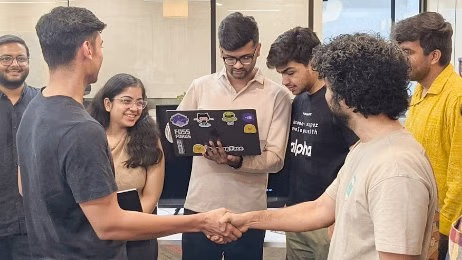Bengaluru: A coding hackathon held in HSR Layout last month highlighted a growing trend in Bengaluru’s tech circles — vibe coding. More than 30 participants, including non-tech professionals and IT workers, gathered to build websites and apps using artificial intelligence (AI) tools instead of traditional programming.
What is Vibe Coding?
Vibe coding involves using AI-powered platforms like Cursor, Replit, Windsurf, Bolt, and Lovable to generate code based on user instructions given in plain English. For example, a user might input, “Create a website to showcase my art portfolio,” and the AI tool will produce the necessary code to build the site.
Vibe coding refers to using AI platforms such as Cursor, Replit, Windsurf, Bolt, and Lovable to create software solutions with simple English prompts like, “Build me a website with a login page and profile dashboard.” These tools allow people without coding skills to quickly design, build, and deploy apps, often within hours. While most platforms offer free versions, many users are paying around $20 (₹1,700) per month to access advanced features.

Hackathon Highlights Innovation
The event, hosted by marketing professionals Nimisha Chanda and Vedant Rawal on March 29, 2025, saw a mix of tech and non-tech participants team up to develop innovative applications. Some of the projects included a fan fiction generator that produced stories in different art styles, chatbots to diagnose health symptoms, apps that correct bad push-up posture, tools that generate novels from a single sentence, and platforms to recommend underrated movies.
One team built a productivity app that fined users for wasting time online, with the collected money donated to charity. Many teams managed to complete working prototypes within the 12-hour timeframe, demonstrating the potential of vibe coding platforms like Replit and Cursor for fast application development.
Non-Tech Professionals Find New Opportunities
Atharva Kharbade, a growth marketer and college dropout, showcased how vibe coding can level the playing field for non-engineers. In March, he built a luxury goods database site, staybroke.in, in just two days. The project went viral online and led to a job offer from a vibe coding startup.
Nimisha Chanda, who taught herself basic Python, Replit, and VS Code through YouTube, said vibe coding helped her create a fintech chatbot explaining tax forms and investment calculations. “If you want good results, be very specific in your prompts — including colors and layout details — otherwise you waste time fixing mistakes,” she advised.
Finance professional Naga Subramanya is also exploring vibe coding to replace traditional Excel tools. He is building a loan repayment calculator with the help of his company’s tech team, focusing on security protocols as the tool will be used internally.
Serial entrepreneur Prasad R, who has a background in computer engineering, is developing an educational platform that auto-generates personalized coloring worksheets for children. He said vibe coding helps him quickly prototype ideas without the need for full-time developers.
Adoption by Large Companies
Vibe coding is not limited to hobbyists. Companies are beginning to integrate AI coding tools into their workflows to speed up product development. Chandramouli Coorg Subramaniam, Senior Vice President of Artificial Intelligence at a global consulting firm, said his teams have shifted from using GitHub Copilot to more advanced tools like Cursor.
According to Subramaniam, AI platforms can now handle about 70–80% of the coding work for internal tools and prototypes. However, debugging remains a major challenge, as AI-generated code can sometimes be inconsistent. He recommends saving work frequently, maintaining internal coding libraries, and clearly defining project goals to avoid major setbacks.
He cautioned that AI coding assistants are not yet suitable for production-grade software and raised concerns about data security and intellectual property when using vibe coding in professional settings.
Training for Beginners
To support the growing interest, Stanford professor Andrew Ng has introduced a short course, “Vibe Coding 101,” in partnership with Replit. The 94-minute course teaches beginners how to use AI tools effectively to create and launch simple web apps. Ng emphasized that while AI can automate much of the coding work, users still need to guide and refine the outputs carefully.
The Ctrl + V(ibe) Hackathon
On March 29, 2025, the “Ctrl + V(ibe)” hackathon took place in HSR Layout, Bengaluru. This 12-hour event brought together over 30 participants, including non-tech professionals and IT experts, to collaborate on AI-driven projects. Teams developed innovative applications such as:LinkedIn
- A fan fiction generator that illustrates stories in various art styles.
- Chatbots designed to diagnose health symptoms.
- Tools to flag incorrect push-up postures.
- Applications that write novels from a single-line brief.
- Platforms to discover underrated films.
- Instagram reel creators featuring AI-generated clones.
- Productivity apps that fine users for wasting time online, donating the amount to charity.
The event emphasized hands-on learning, with mentorship from professionals at companies like Google, Amazon, and Microsoft. Participants were encouraged to launch their products within the 12-hour timeframe, showcasing the rapid development capabilities of vibe coding.